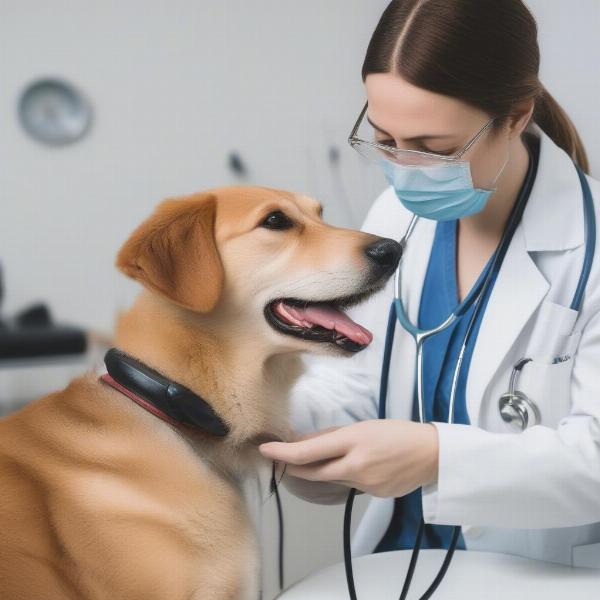Raw dog food diets, often described as “totally natural,” are gaining popularity. But what does a totally natural raw dog food diet actually entail, and is it the right choice for your canine companion? This comprehensive guide will explore the benefits, risks, and practical considerations of feeding your dog a raw food diet, equipping you with the knowledge to make an informed decision.
Understanding Totally Natural Raw Dog Food
Totally natural raw dog food typically consists of uncooked muscle meats, organ meats, bones, fruits, and vegetables. Advocates believe this diet mimics what dogs would eat in the wild and provides optimal nutrition. However, it’s crucial to understand the potential benefits and drawbacks before switching your dog to a raw food diet.
Benefits of a Totally Natural Raw Food Diet
Some proponents of raw feeding claim benefits like improved coat health, increased energy levels, and better dental hygiene. A raw diet can be highly digestible for some dogs, leading to smaller, firmer stools. Furthermore, a carefully planned raw diet can be tailored to meet a dog’s specific nutritional needs, which is particularly beneficial for dogs with allergies or sensitivities.
Risks of Feeding a Totally Natural Raw Diet
Despite the potential benefits, raw feeding carries inherent risks. Raw meat can contain harmful bacteria like Salmonella and E. coli, posing a threat to both dogs and humans handling the food. Nutritional imbalances are another concern if the diet isn’t formulated correctly. Too much bone can cause constipation, while a lack of certain vitamins and minerals can lead to deficiencies.
Transitioning to a Totally Natural Raw Diet
If you decide to transition your dog to a raw food diet, do so gradually. Start by introducing small amounts of raw food alongside their current diet, slowly increasing the proportion of raw food over several weeks. Monitor your dog closely for any digestive upset or changes in behavior.
Nutritional Considerations for a Raw Diet
A balanced raw diet must include the right proportions of muscle meat, organ meat, bone, and fruits and vegetables. Consulting a veterinary nutritionist is highly recommended to ensure your dog’s nutritional needs are met. They can help you create a customized diet plan based on your dog’s breed, age, activity level, and health status.
Is Totally Natural Raw Dog Food Right for Your Dog?
The decision of whether or not to feed your dog a totally natural raw food diet is a personal one. Weigh the potential benefits and risks carefully, and consult with your veterinarian. They can help you assess your dog’s individual needs and determine if a raw diet is a safe and appropriate option.
 Veterinarian Examining Dog
Veterinarian Examining Dog
Common Misconceptions about Raw Feeding
There are several misconceptions surrounding raw feeding. One common myth is that dogs have a short digestive tract, making them well-suited to digesting raw meat. However, dogs have evolved to digest a variety of foods, including cooked meats. Another misconception is that all raw diets are created equal. The nutritional content of a raw diet depends heavily on the ingredients and their proportions.
Sourcing and Preparing Raw Dog Food
Sourcing high-quality ingredients is crucial for a safe and nutritious raw diet. Choose human-grade meats and organic fruits and vegetables whenever possible. Practice proper hygiene when handling raw meat to prevent bacterial contamination.
Conclusion
Totally natural raw dog food diets can offer potential benefits, but they also come with risks. Careful planning, preparation, and monitoring are essential. Consult with your veterinarian and a veterinary nutritionist to determine if a raw diet is the right choice for your dog. A well-balanced, species-appropriate diet, whether raw or cooked, is key to your dog’s long-term health and well-being.
FAQ
- Is a raw diet safe for puppies? While puppies can thrive on a raw diet, it’s crucial to ensure it’s nutritionally balanced to support their growth and development. Consulting with a veterinary nutritionist is especially important for puppies.
- Can I feed my dog bones on a raw diet? Yes, raw bones can be included in a raw diet, but they should be raw and meaty, never cooked. Avoid weight-bearing bones from large animals.
- How do I prevent bacterial contamination with a raw diet? Practice strict hygiene when handling raw meat, wash your hands thoroughly, and use separate cutting boards and utensils.
- Is a raw diet more expensive than commercial kibble? Raw diets can be more expensive than kibble, depending on the ingredients and sourcing.
- What are the signs of a nutritional deficiency in a dog on a raw diet? Signs of deficiencies can include skin problems, dull coat, lethargy, and digestive upset.
ILM Dog is a leading international website dedicated to providing expert advice on dog care and nutrition. We offer a wealth of information on various topics, including breed selection, health care, training, and nutrition. Whether you’re a seasoned dog owner or just starting your journey, ILM Dog is here to support you every step of the way. For expert advice and personalized guidance, contact us at [email protected] or +44 20-3965-8624. Visit ILM Dog today for all your dog care needs!